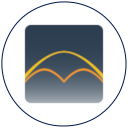SchaMa
Introduction

SchaMa is an acronym for noise control measures (i.e. Schallschutzmaßnahmen). Cervus Consult developed this tool for and on behalf of the Wehrtechnische Dienststelle für Waffen und Munition, WTD 91, Meppen. WTD 91 holds all exploitation rights.
Motive and purpose
For the evaluation of acoustic effectiveness and for the design of active noise control measures, traditional technical acoustic models and calculation methods are not appropriate. These models and procedures are designed for typical noise sources such as road and rail traffic noise, industrial noise or recreational noise and do not take into account the special characteristics of shooting noise.
Shooting noise differs from typical noise sources in four main aspects. All aspects result in the violation of the fundamental assumptions in the models and calculation methods of technical acoustics for the evaluation and design of such measures.
- Shooting noises in the near-source range are high-energy sound pulses and cannot be described with linear acoustics approaches, at least there.
- As a result, a sound shield, for example, can effectively reduce frequency components in the near range, but these components grow again due to non-linear effects, i.e. the signal splits up again.
- Shooting sounds are highly directional sources.
- As a result, the sound component (sound beam) with the shortest path is no longer the decisive factor for determining the shielding effect, but a sound beam with a longer path but higher level.
- Shooting sounds are characterised by particularly low-frequency components.
- As a result, the traditional models for calculating the shielding effect can fail because these models are designed for a so-called ‘middle frequency range’ that determines the A-weighted levels and – as far as is known – have not been validated for the low-frequency noises that are insignificant in typical environmental noise.
- The range of impact of shooting noises from large-calibre weapons extends far beyond 1000 metres.
- As a consequence, the effect of active noise protection measures (e.g. shielding effects) must be determined for a large distance between the construction measure and the receiving site. Here, atmospheric and meteorological influences play a much greater role than for shorter distances between the construction measure and the reception site.
Sound propagation model
SchaMa uses a sound propagation model that basically meets the special requirements. This sound propagation model (SchaMa-CRM) is characterised by the following features:
- Constant radius model (CRM) with unlimited number of ground reflections.
- Description of the ground reflection as spherical wave reflections at complex ground impedance
- Continuous narrow-band signal calculation in Fourier space according to magnitude and phase
- Consideration of three-dimensional directional characteristics of the source
- Native calculation of sound pressure time histories and thus of all level variants with different frequency and time weightings, a unique feature of this model.
Properties and features of SchaMa
The SchaMa-CRM model was implemented as a calculation kernel in the programme ‘SchaMa’. The programme ‘SchaMa’ was developed within the framework of the R&T study and offers the user the possibility to evaluate the effect of active noise control measures (noise screens) for individual immission locations or in the entire neighbourhood as a gridded noise immission plan. SchaMa’ is characterised by the following features:
-
Source specifications
- Signal shapes
- Muzzle blast (Weber model)
- Sonic boom of projectiles
- Wheeled and tracked vehicle pass-by
- Pink and white noise
- Sine and square wave signal
- Import of empirical time signals
- Directivity
- Directivity according to DIN ISO 17201-1
- Elevation of the symmetry axis of the source
- Signal shapes
-
Sound propagation calculation
- SchaMa-CRM
- DIN ISO 9613
- Harmonoise
- (WinLarm)
-
Atmosphere
- Free wind and temperature profiles
- Wind and temperature profiles according to TA Luft
- Radius of curvature models
- ISO 1996
- WTD 91
-
Ground
- Spherical wave reflection at complex impedances
- Ground models
- Wempen (4 parameters)
- Delany/Bazley/Salomons (flow resistance, porosity)
-
Active sound control measures
- Two sound screen sequences with variable height
- Diffraction calculation single screen
- Diffraction calculation double screen
-
Sound receiver
- Single point
- Horizontal grid (maps)
- Vertical raster (sections)
-
Signal calculation
- Fourier spectra
- Time signals
- Third-octave spectra
- Single-number values
Peak, Fmax, Smax, SEL in A-,C- and Z-weighting
-
Tools
- Geometric and acoustic analysis of each partial beam
- Analysis of partial contributions of direct sound and diffracted sound
- Comparison of sound propagation models
- Sound path calculations for all single-number levels
- Sensitivity analysis by variation of all model input parameters
- Variation according to rectangular distribution
- Variation according to Gaussian distribution
- Comparison of weighted and filtered single-number levels
- Representation of the time course of all relevant single-number levels
- Differential analysis of scenarios with/without active noise abatement measures
-
Selections
- Frequently used noise sources
- Sample scenarios
